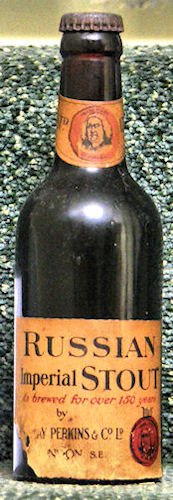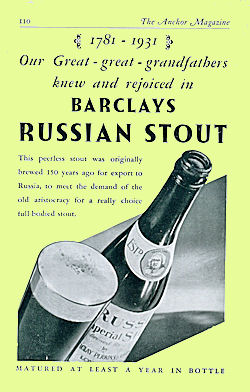I have looked through some of the web sites that cover Russian Imperial Stout. They are so riddled with inaccuracies that I have decided to add my bit to the huge range of information, in the hope of correcting a few errors, and putting the record straight. Please note that Barclay's Imperial Stout is a different brew from Russian Imperial Stout.
Russian Imperial Stout as we knew it was first brewed in 1781 by Barclay Perkins. It was based on a beer that was brewed by its predecessor, Thrales Brewery. It was originally exported to the Baltic, and was especially favoured by the Empress Catherine II of Russia.
Barclay Perkins Brewery of Southwark produced Russian Imperial Stout on a regular basis over the years. It was in the early 1900s that it was produced principally for bottling rather than in cask, although it was probably bottled to a lesser extent earlier than this. Bottling probably came to prominence with the decline of the Baltic trade at the onset of World War I. After World War II it became a 'year beer', one brew being produced annually. From 1949 each brew was dated, although a dated vintage also exists for 1935, which was produced for the Royal Jubilee of that year.

|

|

|
|
An early half pint
|
The 1970s style
|
The most recent style
|
|
DISTINGUISHING PRE- AND POST-WAR BOTTLES
Bottles produced before World War II may be distinguished from post war items by the neck label design. The post-war design persisted into the early 50s. All post war bottles had a date of brewing. However, if the date has been removed, you can distinguish them using Dr. Johnson design neck labels as shown in the image. The one on the left in the picture is pre-war, the one on the right is 1950s. Note the difference in colour of the collar. One is all black and the other has white on it.
|

|
A CHRONOLOGY OF RUSSIAN IMPERIAL STOUT WITH VALUES FOR COLLECTORS
1781 Russian Stout is believed to have first been brewed under the name 'Thrale's Intire'. This name referred to the previous proprietor of the brewery, Henry Thrale.
c1795 Russian Stout known to be exported to places as far apart as Russia and the Baltic region, Sierra Leone, Botany Bay, Germany, Sumatra and Bengal.
Early 1900s Russian Imperial Stout is known to be bottled. Bottles exist with labels with the postal district London SE, without a number. Numbers were added to postal districts in 1917, i.e., London SE1.
c1914 After a period of decline, trade with Russia, the Baltic and Germany stopped.
1920s Russian Imperial Stout brewed annually, and bottled in nips (one third of a pint). Some half pint bottles were produced, mainly for export. All were undated. Value £80-£100
1935 The first known dated bottle of Russian Imperial Stout was produced, commemorating the 1935 Royal Silver Jubilee. It was in a 75cl wired champagne style bottle. Value £350-£400
1940 Brewing of Russian Imperial Stout ceased for the war years.
1946 Russian Imperial Stout was bottled in 75cl wired champagne style bottles and labelled 'Victory Bottling' to commemorate victory in World War II. The beer used was probably brewed before the war and stored through the war years in the 'Russian Cellars' at Southwark, where it survived the blitz. Value £250-£300
1947 or 1948 Russian Imperial Stout was bottled in 75cl wired champagne style bottles and labelled 'Vintage Bottling'. The bottles were not dated despite being called 'Vintage'. This beer used was probably also brewed before the war. Value £200-£250
1949 Brewing of Russian Imperial Stout is known to have recommenced. The first dated nip was produced. Value £45-£50
1950 The normal dated annual bottled nip was produced. Value £45-£50
1951 The normal dated annual bottled nip was produced. Value £45-£50
1952 Label changes to 'as brewed for over 175 years'. This would have been expected to happen in 1956 if the beer had been brewed since 1781. Value £45-£50
1953 The whole production run was bottled in 75cl wired champagne style bottles commemorating the Coronation of Queen Elizabeth II. Value £250-£300
1954 No bottling is known from this year.
1955 Barclay Perkins merged with Courage and Co. to form Courage and Barclay. Labels were changed to reflect this. A dated bottled nip was produced. Value £35-£40
1956 The normal dated annual bottled nip was produced. Value £35-£40
1957 Russian Imperial Stout was bottled in 75cl wired champagne style bottles and labelled 'Vintage Bottling'. The bottles were not dated. It is not possible to tell the difference between this and the 1947/8 bottling. Nips were also produced. Value £35-£40
1958 Brewing was transferred to Courage's Horsleydown brewery, also in Southwark, although maturing continued to be carried out in the 'Russian Cellars' at the original Barclay Perkins brewery. The normal dated annual bottled nip was produced. Value £30-£35
1959 The normal dated annual bottled nip was produced. Value £30-£35
1960 The normal dated annual bottled nip was produced. Value £30-£35
1961 The normal dated annual bottled nip was produced. Value £25-£30
1962 The normal dated annual bottled nip was produced. Value £25-£30
1963 No brew was produced.
1964 No brew was produced.
1965 No brew was produced.
1966 The normal dated annual bottled nip was produced. Value £25-£30
1967 The normal dated annual bottled nip was produced. Value £25-£30
1968 The normal dated annual bottled nip was produced. Value £25-£30
1969 The normal dated annual bottled nip was produced. Value £25-£30
1970 The label design was changed, and the name was changed to Imperial Russian Stout. Nips exist for this year with both label designs. Older label design Value £25-£30. Newer label design, value £20-£25
1971 The normal dated annual bottled nip was produced. Value £20-£25
1972 The normal dated annual bottled nip was produced. Value £20-£25
1973 The normal dated annual bottled nip was produced. Value £20-£25
1974 The normal dated annual bottled nip was produced. Value £20-£25
1975 The normal dated annual bottled nip was produced. Value £20-£25
1976 The normal dated annual bottled nip was produced. Value £20-£25
1977 A minor label design change took place. Bottles dated 1977 exist with both designs of label. Value £20-£25 (either label design)
1978 The normal dated annual bottled nip was produced. Value £20-£25
1979 No bottling exists for this year.
1980 The normal dated annual bottled nip was produced. Value £20-£25
1981 Brewing moved to John Smith's brewery in Tadcaster, Yorkshire. Label changed to 'as brewed for over 200 years'. A dated bottled nip was produced. Value £20-£25
1982 25cl bottles were produced for export to Belgium or France. No nips are known for this year. Value £20-£30
1983 25cl bottles were produced for export to Belgium and France. No nips are known for this year. Value £10-£15
1984 The label design was changed. Value £10-£15
1985 A dated bottled nip was produced. Value £10-£15
1986 No bottling exists for this year.
1987 No bottling exists for this year.
1988 No bottling exists for this year.
1989 Bottling resumed after a gap of three years. Value £10-£15
1990 No bottling exists for this year.
1991 No bottling exists for this year.
1992 A dated bottled nip was produced. Value £10-£15
1993 The final bottling of Imperial Russian Stout was produced, dated 1993, and production ceased without any fanfare. Value £10-£15.
2007 A special bottling was produced to celebrate the career of Gilbert Bauer Group Technical and R&D Director. Value £50-£75.
Books you may find of interest.





